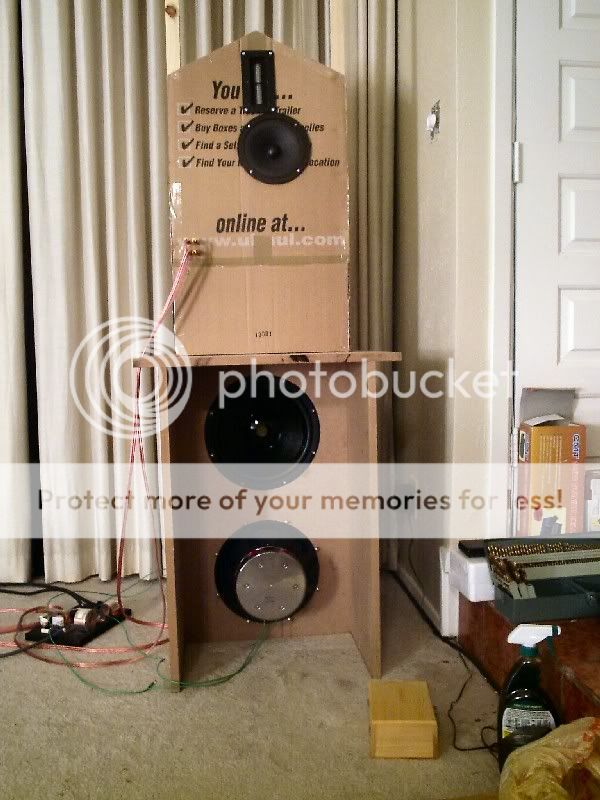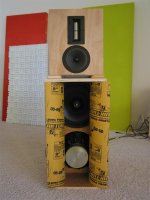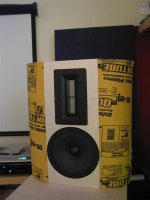Here it is, after 5 months of work testing and tuning the midrange and tweeter in cardboard baffles. I've finally assembled the guts of the h-frame to house the woofers. I'm using a scrap piece of MDF for the top and the bottom just sits on carpet untill I can cut a top/bottom piece. The upper mid/tweet panel is now too tall. I aded an extra 12" so it could stand without the bass section and still be high enough to listen so it looks a little goofy until I shorten the upper panel some.
I'm going to cut and assemble the other H-frame for the left channel this weekend and then work on the tops/bottoms and mid/tweet panels.
Comments welcome

--Chris
I'm going to cut and assemble the other H-frame for the left channel this weekend and then work on the tops/bottoms and mid/tweet panels.
Comments welcome

--Chris
Looking good! You just need to put a hinge on that baffle.
I also just built an H-frame in an attempt to solve a 100-200Hz suckout I've been experiencing.
I'm experimenting with columns in the mouth both as an aesthetic enhancement as well as one that has performance benefits.
From my RTA measurments, the H-frame with columns helps reduce a peak at 1k by about 5dB. Also helps the suckout which appears to be room related. (placement and mic position change its behavior)
The columns were an idea I got from Larry Selmer. Cutting them in half to keep the box to a nominal width was someone elses and passed on to me by Larry.
I'm building a second H-frame, slightly deeper and wider to better accomodate 8" diameter columns. The whole thing is sized to ensure I have an area between the columns equal to the combined Sd of my 12" woofers ~164in^2.
The simple baffle for the mid and tweet is just something basic to get me by since the original baffle it replaces held all the drivers. But it sounds nice. For the right channel I'm going to use some extra sonotube to make a curved baffle for mid/tweet.
I also just built an H-frame in an attempt to solve a 100-200Hz suckout I've been experiencing.
I'm experimenting with columns in the mouth both as an aesthetic enhancement as well as one that has performance benefits.
From my RTA measurments, the H-frame with columns helps reduce a peak at 1k by about 5dB. Also helps the suckout which appears to be room related. (placement and mic position change its behavior)
The columns were an idea I got from Larry Selmer. Cutting them in half to keep the box to a nominal width was someone elses and passed on to me by Larry.
I'm building a second H-frame, slightly deeper and wider to better accomodate 8" diameter columns. The whole thing is sized to ensure I have an area between the columns equal to the combined Sd of my 12" woofers ~164in^2.
The simple baffle for the mid and tweet is just something basic to get me by since the original baffle it replaces held all the drivers. But it sounds nice. For the right channel I'm going to use some extra sonotube to make a curved baffle for mid/tweet.
Attachments
Brian,
Good to see you're still working on your project. Why worry about 1K for the bass baffle? What are you crossing your woofers at?
My h-frame center section is 18" wide and 30" tall. The frame is 24" deep.
I'm adding 18db of equalization at 6db per octive lp shelving filter from 40hz to 320hz and crossing to the midrange at 250hz with 4th order active filter. RTA is flat with some minor room modes I had to supress.
Are you sure you're not creating a serious resonance with such a small opening infront of your woofers by adding the collumns?
Best of luck on your dipole, and keep us updated, hows the sound?
--Chris
Good to see you're still working on your project. Why worry about 1K for the bass baffle? What are you crossing your woofers at?
My h-frame center section is 18" wide and 30" tall. The frame is 24" deep.
I'm adding 18db of equalization at 6db per octive lp shelving filter from 40hz to 320hz and crossing to the midrange at 250hz with 4th order active filter. RTA is flat with some minor room modes I had to supress.
Are you sure you're not creating a serious resonance with such a small opening infront of your woofers by adding the collumns?
Best of luck on your dipole, and keep us updated, hows the sound?
--Chris
I'm crossing over at about 300Hz. I'm not concerned about it. I just noticed it when I went to H-frame and how the columns helped get rid of it.
I don't remember my exact measurements but mine's about 26" tall, 14" wide and 18" deep.
For the woofers, I'm using something a little different. I'm using a low pass 1st order at 26Hz (Fs) on the woofers. It flattens things out nicely. The mid is also using a 1st order at 300Hz but I think it really measures closer to 12dB due to dipole cancellation.
I think it all sounds really good but I'm still just scratching the surface. I'm certainly not missing my Ellis 1801s. However, the DCX hiss is still somewhat of an issue and now my freshly rebuilt high-gain Grounded Grid preamp has an intermittent buzz I need to track down. I find these issues to be the most annoying.
I just started building a Wallin jig and hope to use Speaker Workshop to design a passive mid/tweet crossover in the coming weeks.
I don't remember my exact measurements but mine's about 26" tall, 14" wide and 18" deep.
For the woofers, I'm using something a little different. I'm using a low pass 1st order at 26Hz (Fs) on the woofers. It flattens things out nicely. The mid is also using a 1st order at 300Hz but I think it really measures closer to 12dB due to dipole cancellation.
I think it all sounds really good but I'm still just scratching the surface. I'm certainly not missing my Ellis 1801s. However, the DCX hiss is still somewhat of an issue and now my freshly rebuilt high-gain Grounded Grid preamp has an intermittent buzz I need to track down. I find these issues to be the most annoying.
I just started building a Wallin jig and hope to use Speaker Workshop to design a passive mid/tweet crossover in the coming weeks.
I'm using a 6db/oct low pass shelving filter to compensate for the baffle roll-off. I'm also using pro-sound amps with built in gain controls so I can run the maximum input into the DCX and then lower the gain of the power amps which helps with the hiss. The inherant problem with high sensativity speakers is that you pick up all the low level noise and make it pretty audible 🙁 Oh well, its worth it for the effortless sound they produce..
--Chris
--Chris
What did you end up with for a mid/tweet crossover?
I'm using LR12 at 3k I think. I just picked it as a starting point and haven't really tried to mess with it too much. Tried 1st order but A/B'ing, I liked LR12 better.
Looking at the Audax plots, it looks as though 2k might be better for polar response.
I'm using LR12 at 3k I think. I just picked it as a starting point and haven't really tried to mess with it too much. Tried 1st order but A/B'ing, I liked LR12 better.
Looking at the Audax plots, it looks as though 2k might be better for polar response.
I've been playing with the mid/tweet crossover for a while. Currently its set at 2.5K LR48 but I've had it as low as 1.5K.
I've been messing with the higher frequency crossover because I noticed that the tweeter was playing some of the higher female vocals at the lower crossover. I wanted to keep all the vocal on one driver.
The audax looked pretty good at 2.5K, and the steep crossover keeps me out of the breakup/off axis dip
--Chris
I've been messing with the higher frequency crossover because I noticed that the tweeter was playing some of the higher female vocals at the lower crossover. I wanted to keep all the vocal on one driver.
The audax looked pretty good at 2.5K, and the steep crossover keeps me out of the breakup/off axis dip
--Chris
So I finished my second H-frame and the Bat-Baffle (see attached pic).
The baffle didn't measure as smoothly as my flat one. Resistively loading the rear helped but ultimately not as good.
One problem I ran into today was that the deep H-frame screws up the midrange response unless the midrange panel is moved to the front edge. Not really that suprising. However, the result is somewhat less pleasing to my living room decor. My H-frame is 18.5" d x 15" w x 27.5" h.
Slowly but surely my speaker is evolving into retarded brother of an Orion.
BTW, what tools are you using to work out your design? I've been using TrueRTA trying in vain to make 1/24th octave traces look smooth. It's a fun tool but may not be ideal. I've printed out the Speaker Workshop manual and have been reading it as time allows. I'd like to try and use some its design tools.
The baffle didn't measure as smoothly as my flat one. Resistively loading the rear helped but ultimately not as good.
One problem I ran into today was that the deep H-frame screws up the midrange response unless the midrange panel is moved to the front edge. Not really that suprising. However, the result is somewhat less pleasing to my living room decor. My H-frame is 18.5" d x 15" w x 27.5" h.
Slowly but surely my speaker is evolving into retarded brother of an Orion.
BTW, what tools are you using to work out your design? I've been using TrueRTA trying in vain to make 1/24th octave traces look smooth. It's a fun tool but may not be ideal. I've printed out the Speaker Workshop manual and have been reading it as time allows. I'd like to try and use some its design tools.
Attachments
I've been tuning by ear and using the 1/3 octave RTA built into my DEQ2496. I was planning on setting up speaker workshop but got distracted with all the knobs and switches on the DEQ 😉
Not sure how accurate the DEQ is, but making changes using the RTA function sounds good to my ear 😉
--Chris
Not sure how accurate the DEQ is, but making changes using the RTA function sounds good to my ear 😉
--Chris
Switching to 1/3rd octave makes everything look pretty good.
I've noticed that unless I have some major phase cancellation problem, as long as the driver levels are close, it sounds pretty good.
When I play with the DCX with my PC, I get some annoying noises through my speakers. Disonnecting the PC fixes the problem. Have you experienced this?
I've noticed that unless I have some major phase cancellation problem, as long as the driver levels are close, it sounds pretty good.
When I play with the DCX with my PC, I get some annoying noises through my speakers. Disonnecting the PC fixes the problem. Have you experienced this?
no I haven't noticed anything like that... But I'm using a laptop so its running on battery instead of wall power, really quiet.
The DEQ's RTA has 1/2 octave as its finest resolution.. Even then I noticed some room nodes that cause peaks and nulls at 5K and 300hz. The DEQ was real nice to equalize them out..
--Chris
The DEQ's RTA has 1/2 octave as its finest resolution.. Even then I noticed some room nodes that cause peaks and nulls at 5K and 300hz. The DEQ was real nice to equalize them out..
--Chris
DIY_newbie said:The DEQ's RTA has 1/2 octave as its finest resolution.. Even then I noticed some room nodes that cause peaks and nulls at 5K and 300hz. The DEQ was real nice to equalize them out..
--Chris
Actually 1/6 octave is the finest resolution, it's not perfect but it's not too bad
http://www.behringer.com/DEQ2496/index.cfm?lang=ENG
Where did you get the 1/6 octave number? I need to go back to the manual and check. The finest setting I can set mine on is 1/3 octave. Maybe I need to upgrade my firmware..
--Chris
--Chris
IMO, a RTA lacks sufficient resolution to measure drivers for the purpose of designing crossovers. Investing in a MLS software package would be money well spent.
Nice work btw.
Nice work btw.
An externally hosted image should be here but it was not working when we last tested it.
Beau said:What woofers are you guys using, looks like Lambda and Focal?
Not sure what Chris is using but I'm using the Lambda Dipole 12.
Mac, you had the Orions before didn't you? I think I recognize the screens in the background from a photo on Linkwitz's site. (oh wait, your avatar...)
Do you have an MLS package recommendation?
Do you have an MLS package recommendation?
DIY_newbie said:Where did you get the 1/6 octave number? I need to go back to the manual and check. The finest setting I can set mine on is 1/3 octave. Maybe I need to upgrade my firmware..
--Chris
The GEQ is 1/3 octave, but if you check the manual you'll see that it has a 61 band RTA, 61 band is 1/6 octave.
ultrachrome said:Mac, you had the Orions before didn't you? I think I recognize the screens in the background from a photo on Linkwitz's site. (oh wait, your avatar...)
Do you have an MLS package recommendation?
Yep, those were my Orions. 🙂
I use JustMLS, which is part of LspCAD, and an ECM-8000 along with a Rolls mic preamp. Another good software package is SoundEasy.
A RTA doesn't do gating so you end up measuring the room rather than the speakers.
mac said:
A RTA doesn't do gating so you end up measuring the room rather than the speakers.
Isn't this exactly what you want? Unless the speakers are going to stand in an open field you want the response of the speakers and the room combined at the listening position... Or am I missing something?
--Chris
- Status
- Not open for further replies.
- Home
- Loudspeakers
- Multi-Way
- JP2.0 Part IV A.K.A. first test photos don't make fun of my cardboard

